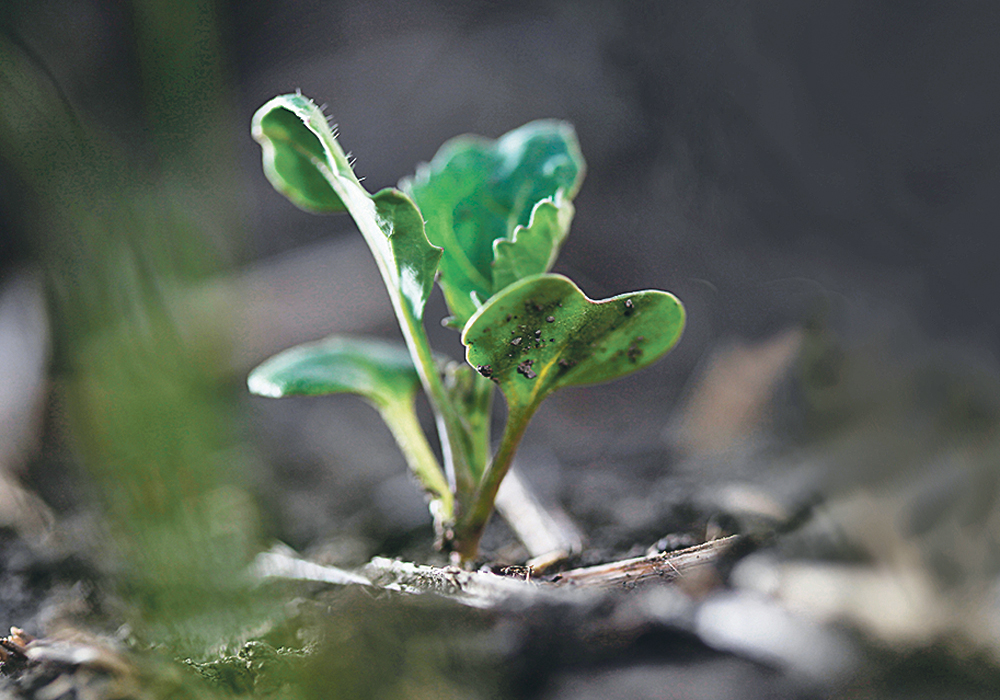Crops can tolerate spring frost better than early fall frost. To offset the cold stress associated with early seeding, follow these best management practices:
Seed as early as possible
Weather changes at this time of year make it difficult to predict when growers will be on the land.
Growers are starting to seed as I write this in mid-April, and in the extreme south of Alberta, they have already wrapped up.
I checked soil temperatures April 20 and found that they are already starting to climb. Temperatures in a worked stubble field were 5.8 C and 2.4 C at one and two inch depths, respectively. In a fallow field, they were 9 C and 4.7 C for the same depths. These temperatures were taken at 3 p.m.
Read Also

Growing garlic by the thousands in Manitoba
Grower holds a planting party day every fall as a crowd gathers to help put 28,000 plants, and sometimes more, into theground
Most crops grown in Western Canada will germinate at 5 C, which means that the temperatures recorded in the fallow field are already near or at that level.
However, germination and seedling growth are more variable and slower when soil temperatures are low. Germination and emergence become faster and more uniform as temperatures increase.
Emergence time is generally reduced by half for every 5 C increase between 5 C and 20 C.
Warmer soil temperatures also result in a higher percentage of plant emergence.
It’s interesting to note that the same fields had temperatures of 2.1 C and 2.7 C at a one inch depth at 8 a.m.
Several factors influence soil temperatures and the rate of warming.
Soil temperature varies with time and depth and is determined by the radiation reaching the soil surface. Frost in the soil will cool the temperature when not exposed to the sun. Type and quantity of surface residue, as well as the heat capacity of the soil, will also influence the rate of soil heat gain.
Early seeding usually results in maximum yields for most crops. There are several factors that contribute to this:
Early seeded crops will better use available soil moisture. Later seeding will reduce the probability of receiving a given level of total precipitation during the growing season. Environment Canada data from southwestern Manitoba indicates that the probability of receiving total moisture based on initial soil moisture is reduced from 50 percent for a crop seeded May 1 to 36 percent if seeded May 22.
Heat stress during flowering can hurt flowering and seed set. A crop that is seeded early flowers earlier and thus avoids the heat that is typically associated with July. This is especially important in canola because it is sensitive to heat during flowering.
Early seeded crops avoid many insect and disease problems by beating the peak infestation or infection period.
There is a wider window of opportunity for timely weed control in early seeded crops.
Early seeded crops have higher quality: heavier grain from cereals and higher oil content from oilseeds. Pulses have higher overall quality.
Early seeding leads to earlier harvesting. Harvesting conditions are usually much more favourable during August and early September compared to the conditions that follow.
Crop yields will typically increase with early seeding, which is mid to late April or early May, depending on location.
So, those are the rewards, but what about the risks?
Frost is probably the biggest risk, and crops vary in their ability to withstand frost.
With cereals, the growing point is below ground until approximately the five-leaf stage. This protects the plant from severe frost injury in the spring. The plants may lose above ground leaves but will re-grow from below ground.
Other damage can be seen on the tips of leaves or leaf edges, which can become yellow and then turn brown and become brittle.
Severe injury to cereals where all above-ground matter is damaged can result in a delay in maturity because the plant has to regrow.
The growing point with canola and mustard is above ground between the cotyledons. Newly emerged canola and mustard at the cotyledon stage can be susceptible to spring frosts.
However, plants emerging while conditions are cold can withstand temperatures of -3 to -4 C. Plants that are growing in cold soil (-1 to -5 C) at the three to four-leaf stage may be even more tolerant. A light frost that burns the leaves may not injure the growing point.
To determine the viability of the damaged seedlings, the growing point needs to be green and viable and the stem healthy.
Flax is quite sensitive to frost when it is emerging but becomes more tolerant as it grows.
Necrotic wounds called frost cankers can be a problem with flax during early stages of growth. These cankers allow disease organisms to enter the plant, leading to death and reducing stands by as much as 50 percent.
Damage is most severe in thin stands on light soil and in low spots.
Symptoms of frost canker are similar to heat canker. There will be plants or areas in the field where the plants have fallen over. At or near the soil surface, the plants will be girdled and have constricted stems.
Peas and lentils have good frost tolerance because they have buds that usually remain below ground during early development. The above ground growth may be severely injured by frost, but new growth will resume from the scale buds.
Most crops will germinate at 5 C, but the speed of crop emergence will increase as the soil temperature increases.
While there is an increased risk to frost and poor emergence due to disease, most early seeded crops will out-yield later seeded crops in most years.
Producers have experienced a longer growing season recently with more frost-free days. In the last five years, the increase in frost-free days has come from later fall frosts.
However, long-term data shows that the first fall frost date has remained constant. The lengthening has been because of earlier last-spring frosts.
Over the past 20 years, I have observed that the optimum planting dates correspond with the leafing out of native aspens. By optimum, I mean that a producer should try to have at least one-third of his crop planted by this point because you can’t plant everything on the optimum date. This optimum date has varied from the last week of April to after the Victoria Day holiday.
Seed shallow
Most crops can be seeded at the low end of recommended seeding depths because moisture is usually ample early in the spring. This would be one to 1.5 inches for cereals and peas and .5 inches for canola. It will allow crops to germinate and get out of the ground as soon as possible.
Use a seed treatment
Germination and emergence are slower at lower temperatures, and germinating seeds are subjected to disease organisms on the seed and in the soil for longer periods of time. The largest benefits are seen on early seeded fields. This is critical with seed quality being poor this year.
Use better quality seed
Emerging seedlings need to keep any extra energy. Farmers who have seed of differing quality should plant the better seed into the early planting window.
Apply starter fertilizer
Early seeded crops benefit from seed-row applied starter phosphate fertilizer. Yield and maturity benefits from seed-row phosphate are maximized in early seeding situations. Farmers who plan to reduce their rates of phosphate fertilizer should not consider early seeding. Do not go beyond recommended rates of seed-row urea because seed-row nitrogen can stress emerging crops.
Control weeds early
Early weed control is essential for top yields. Plan to spray early to remove weed competition if a pre-seeding burnoff is not accomplished because of a lack of weed growth.
Oat seeding may be delayed to control wild oats. However, seeding early and heavy has proven to limit the impact of wild oats in light to moderate infestations.
Canola seeded early will harden off and be able to withstand frost below –5 C. However, extensive frost damage has been observed in areas of the field where heavy trash is present. Only fields with good residue spreading should be considered for early direct seeding of canola.
Canola, barley, wheat, peas and oats should be considered first for seeding.
Thom Weir, PAg. is an agrologist with Farmer’s Edge. He can be reached by emailing thom.weir@farmersedge.ca.


















